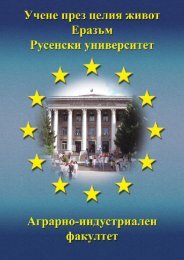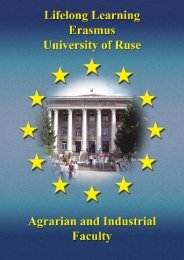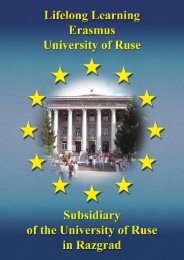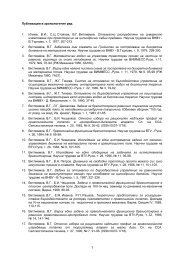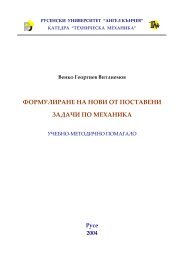Erasmus ECTS Information Package
Erasmus ECTS Information Package
Erasmus ECTS Information Package
You also want an ePaper? Increase the reach of your titles
YUMPU automatically turns print PDFs into web optimized ePapers that Google loves.
<strong>Erasmus</strong> <strong>ECTS</strong> <strong>Information</strong> <strong>Package</strong><br />
Faculty of EEEA<br />
3235 High Voltage Technique<br />
<strong>ECTS</strong> credits: 5<br />
Weekly classes: 2lec+1sem+1labs+0ps+1ca<br />
Assessment: exam<br />
Type of exam: written and oral<br />
Departments involved:<br />
Department of Electrical Power Engineering<br />
Faculty of Electrical Engineering, Electronics and Automation<br />
Lecturers:<br />
Assoc. Prof. Kyril Aleksandrov Sirakov, MEng, PhD, Dept. of Electrical Power Engineering,<br />
tel.: 082 888 364, E-mail: csirakov@uni-ruse.bg<br />
Principal Assistant Anka Hristova Krasteva, MEng, PhD, Dept. of Electrical Power Engineering,<br />
tel.: 082 888 301,E-mail: akrasteva@uni-ruse.bg<br />
Abstract:<br />
The subject includes: mechanism of the progress of discharge and pierces in gaseous, solid and liquid dielectrics;<br />
kinds of voltage, reasons for their advent and their impact on technical devices and biological objects; technical<br />
instruments for protection from over voltage. The students receive theoretical and practical knowledge needed for<br />
the design and exploitation of the electro-energetic system and its elements. Course pre-requisites include<br />
Electrical materials, Theoretical electrical engineering, Electrical networks and systems and others. The course<br />
outcomes are connected with subjects as Electric part of the power plants, Relay protection, Electrical power<br />
supply, Diploma thesis.<br />
Course content:<br />
Sources for high voltage. Mechanism of the electric discharge in gases. Electrical catenary. Corona during high<br />
voltage. Discharge in gaseous, solid and combined isolation. Electric wave transitional processes. Breakdown<br />
voltage. Atmospheric over voltages, lightning and lightning protection. Protection from over voltages. Coordination<br />
of the isolation.<br />
Teaching and assessment:<br />
Teaching is based on lectures and laboratory exercises. The laboratory exercises are conducted at an interval of<br />
two weeks and last two academic hours. The first exercise is preceded by safety instructions for working with high<br />
voltage devices.<br />
Continuous assessment is done through examining the students before the particular exercise and students are<br />
then expected to submit a report on the exercise. The exam is based on two questions from the lecture material<br />
supplemented by an oral exam on some of the main problems of the subject.<br />
3236 Electrical Machines 2<br />
<strong>ECTS</strong> credits: 7<br />
Weekly classes: 3lec+0sem+3labs+0ps+2cw<br />
Assessment: exam<br />
Type of exam: written<br />
Departments involved:<br />
Department of Electrical Power Engineering<br />
Faculty of Electrical Engineering, Electronics and Automation<br />
Lecturers:<br />
Assoc. Prof. Dimo Nejkov Dimov, MEng, PhD, Dept. of Electrical Power Engineering, tel.: 082 888 659,<br />
E-mail: dnd@uni-ruse.bg<br />
Abstract:<br />
The subject has the objective to acquaint the students with the induction and synchronous machines arrangement,<br />
principle action, theory, characteristics and research methods.<br />
Input links include: Higher Mathematics, Physics, Theory of Electrical Engineering and Electrical Machines 1.<br />
Output links include: Automatic Electric Drive, Electrical Equipment and Electrical Transport.<br />
Course content:<br />
General issues of the alternative current machines theory: windings, electromotive force, magnetomotive force,<br />
magnetic fields and inductive reactance of the alternative current windings. Induction machines arrangement and<br />
principle action. Modes of operation. Circuit and vector diagrams. Electromagnetic torque. Starting and speed<br />
control. Special types of induction machines. Synchronous machine arrangement and principle action. Types.<br />
Modes of operation. Synchronous generators. Vector diagrams. Work in parallel. Angular characteristics. Static<br />
stability. Synchronous motors. Starting. Special types of synchronous machines. Collector alternating current<br />
motors.<br />
Teaching and assessment:<br />
The theoretical basic issues on all topics from the syllabus, presented at the lectures, are further practiced during<br />
the laboratory exercises. Learning practice consists also of preparing course work. The students must prepare for<br />
the laboratory exercise in advance. The exam is conducted in written form and consists of three subject questions.<br />
The final exam mark depends on the mark received for the laboratory exercises and course work that is submitted<br />
before the beginning of the exam session.<br />
67



